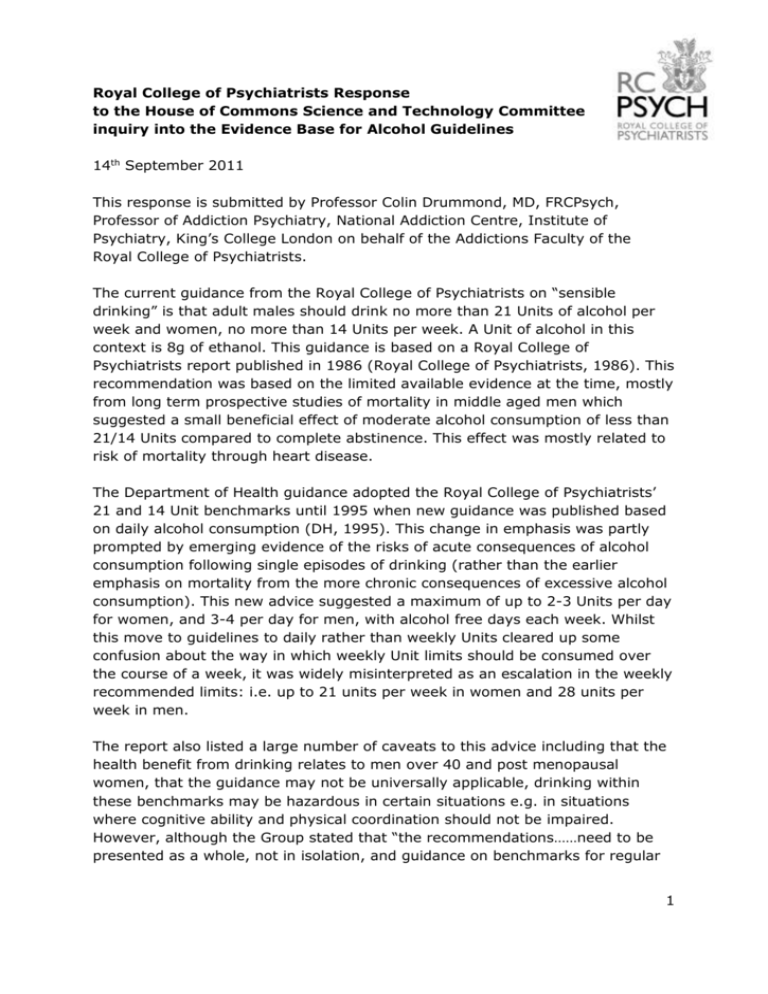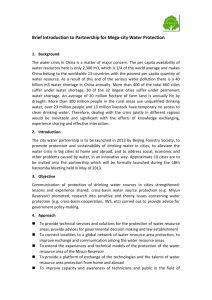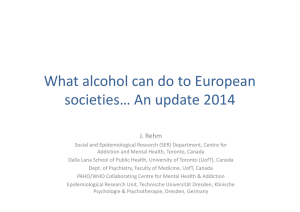Evidence to House of Commons Science and Technology
advertisement

Royal College of Psychiatrists Response to the House of Commons Science and Technology Committee inquiry into the Evidence Base for Alcohol Guidelines 14th September 2011 This response is submitted by Professor Colin Drummond, MD, FRCPsych, Professor of Addiction Psychiatry, National Addiction Centre, Institute of Psychiatry, King’s College London on behalf of the Addictions Faculty of the Royal College of Psychiatrists. The current guidance from the Royal College of Psychiatrists on “sensible drinking” is that adult males should drink no more than 21 Units of alcohol per week and women, no more than 14 Units per week. A Unit of alcohol in this context is 8g of ethanol. This guidance is based on a Royal College of Psychiatrists report published in 1986 (Royal College of Psychiatrists, 1986). This recommendation was based on the limited available evidence at the time, mostly from long term prospective studies of mortality in middle aged men which suggested a small beneficial effect of moderate alcohol consumption of less than 21/14 Units compared to complete abstinence. This effect was mostly related to risk of mortality through heart disease. The Department of Health guidance adopted the Royal College of Psychiatrists’ 21 and 14 Unit benchmarks until 1995 when new guidance was published based on daily alcohol consumption (DH, 1995). This change in emphasis was partly prompted by emerging evidence of the risks of acute consequences of alcohol consumption following single episodes of drinking (rather than the earlier emphasis on mortality from the more chronic consequences of excessive alcohol consumption). This new advice suggested a maximum of up to 2-3 Units per day for women, and 3-4 per day for men, with alcohol free days each week. Whilst this move to guidelines to daily rather than weekly Units cleared up some confusion about the way in which weekly Unit limits should be consumed over the course of a week, it was widely misinterpreted as an escalation in the weekly recommended limits: i.e. up to 21 units per week in women and 28 units per week in men. The report also listed a large number of caveats to this advice including that the health benefit from drinking relates to men over 40 and post menopausal women, that the guidance may not be universally applicable, drinking within these benchmarks may be hazardous in certain situations e.g. in situations where cognitive ability and physical coordination should not be impaired. However, although the Group stated that “the recommendations……need to be presented as a whole, not in isolation, and guidance on benchmarks for regular 1 drinking must be present in the context of the overall risks and benefits from drinking” this has rarely been the case in official public information. Some of the conclusions of the report were not translated into public health messages by the Department of Health. For example the report stated that “all cause mortality is at its lowest at modest drinking levels (at about 1 unit a day for men and women) and does not exceed the mortality level of abstainers until consumption levels which are somewhat higher than the current recommended sensible drinking levels of 14 units per week for women and 21 units for men.” So the Group identified from the evidence that a lower level of alcohol consumption than the then recommended sensible level of 21/14 units per week conferred the lowest risk of mortality: i.e. closer to 7 units per week for both men and women. It has subsequently been recognized that part of the explanation for abstainers having a higher mortality rate than moderate drinkers may be due to current abstainers containing a proportion who are former heavy drinkers, and therefore have potentially already increased their mortality risk through historical excessive drinking, and a proportion who are unable to consume alcohol because of pre-existing physical or psychiatric illness who may also be at higher risk of premature mortality. Since these landmark reports on which current guidance is loosely based a number of factors suggest that a review of the guidance would be timely. 1. The typical size and strength of alcohol drinks has increased. Whereas at the time of the Royal College of Psychiatrists report beer and cider sold in licensed premises was typically 3-4% alcohol by volume (ABV), several popular beer brands are now 5% ABV or greater, and super strength cider is often closer to 8-9% ABV. Similarly there has been a trend towards marketing of higher ABV wines. The size of measures particularly of wine sold in licensed premises has also generally increased to 2-3 Units rather than 1 Unit in 1986. Spirits are often now sold in litre rather than 70 cl bottles in supermarkets. On license spirits are often promoted as double measures. Surveys have shown that public knowledge of the Unit content of alcohol drinks has always been limited. But what knowledge there is has been confounded by an escalation in alcoholic drink measures and strengths. 2. Research published since the Department of Health report (DH, 1995) on which current public guidance is largely based, has suggested that the health benefits of moderate alcohol consumption have been overestimated. A recent World Health Organisation (2007) report noted that the wide inter-individual variation in susceptibility to the adverse effects of alcohol suggests that it is not possible to recommend a level of alcohol consumption at which alcohol is universally safe. The report also noted 2 “Even in societies where heart disease is a very important cause of death, the overall number of lost years of life attributable to drinking outweighs the saved years attributable to protective effects.” (p.9). 3. The harms caused by alcohol are not restricted to the individual drinker or to health. A wider perspective of the harms to third parties and society as a whole need to be considered in framing guidance (WHO, 2007). 4. Alcohol disproportionately harms the poorest and most vulnerable in society at a given level of alcohol consumption leading to significant health inequalities (Marmot et al., 2010). 5. Although the UK has had recommended sensible drinking limits promoted by the Department of Health since 1986, alcohol related harm in the UK has increased dramatically over that period. This calls into question the impact of sensible drinking guidelines alone as a public health strategy. The WHO (2007) and Babor et al. (2010) conclude that sensible drinking messages alone are ineffective in reducing alcohol consumption and alcohol related harm. More effective strategies include increasing the price and restricting availability of alcohol. If public health messages have an impact it is restricted to supporting other more effective strategies, rather then conferring benefits alone. Specifically the House of Commons Science and Technology Committee should consider the following evidence in its enquiry: 1. The World Health Organisation (2007) expert committee report on problems related to alcohol consumption as discussed above. 2. Rehm et al. (2008) modeled risks of mortality and found that for “chronic disease death, lifetime risk increases by about 10% with each 10-gram (one drink) increase in daily alcohol consumption...” “…..both men and women should not exceed a volume of two drinks a day for chronic disease mortality, and for occasional drinking three to four drinks seem tolerable.” 3. Taylor et al. (2008) based on Canadian data found that “the probability of mortality was 1 in 100 for all levels of consumption above 3 drinks 3 times per week for men and above 5 drinks 3 times per week for women.” They concluded that “No safe level of consumption is recommended based on the results, although risk is much lower consuming 3 standard drinks or less fewer than 3 times per week.” 3 4. The Australian Government National Health and Medical Research Council (2009) published a review of the international literature of the health risks of alcohol as a basis for Australian national guidance. The report concluded, inter alia, that “the lifetime risk of harm from drinking alcohol increases with the amount consumed. For healthy men and women, drinking no more than two standard drinks on any day reduces the lifetime risk of harm from alcohol related disease or injury.” As in the Department of Health (1995) report, this report contains a series of caveats about particular at risk groups and for whom these benchmarks will be too high, as well as specific situations in which this level of alcohol consumption may be harmful. 5. White et al (2002) found a direct dose response relationship between alcohol consumption and risk of death in women aged 16-54 and men aged 16-34. They concluded that “Substantially increased risks of all cause mortality can occur even in people drinking lower than recommended limits, and especially among younger people.” 6. The Royal College of Psychiatrists (2011) has published a report on alcohol related harm in the elderly. The report concluded that “Because of physiological and metabolic changes associated with ageing, these [Department of Health] ‘safe limits’ are too high for older people; recent evidence suggests that the upper ‘safe limit’ for older people is 1.5 units per day or 11 units per week.” 7. The WHO (2010) has published a monograph prepared by the International Agency for Research on Cancer on the carcinogenic risks of alcohol and ethyl carbimide. The report concluded that both alcoholic beverages and ethanol in alcoholic beverages are Group 1 carcinogens in humans. The IARC recommends no exposure to Group 1 carcinogens. All alcohol related cancers have linear or near linear dose response relationships with alcohol, suggesting there is no universally safe level of alcohol consumption in relation to the risk of developing cancer. In conclusion the Royal College of Psychiatrists recommends that the House of Commons Science and Technology Committee should take into account new evidence which calls into question the validity of the current Department of Health guidance on alcohol consumption. Such a review needs to take account of all consequences of alcohol consumption including morbidity, mortality and social harms and consequences rather than focusing on a specific aspect. Recent evidence on the carcinogenic effects of alcohol call into question guidance based primarily on risks of heart disease. Both daily and weekly levels of consumption as well as patterns need to be considered. 4 It should be noted, however, that the evidence shows that sensible drinking guidelines are in themselves an ineffective public health strategy to reduce alcohol related harm unless they are issued in support of more effective strategies such as increased price and restricted availability of alcohol. It is further recommended that an appropriate scientific review of the evidence should be conducted by scientists who are independent of the alcohol industry and that any scientist engaged in such a review should provide a full disclosure of any competing interests. References Australian Government National Health and Medical Research Council (2009) Australian Guidelines to Reduce Health Risks from Drinking Alcohol. Commonwealth of Australia, Canberra. Babor et al. (2010) Alcohol: No Ordinary Commodity, 2nd ed. Oxford University Press, Oxford. Department of Health (1995) Sensible Drinking: Report of an InterDepartmental Working Group. DH, London. Marmot et al. (2010) Strategic Review of Health Inequalities in England Post2010. The Marmot Review, London. Rehm, J, Room, R, Taylor, B (2008) Method for moderation: measuring lifetime risk of alcohol-attributable mortality as a basis for drinking guidelines. International Journal of Methods in Psychiatric Research, 17(3): 141-151. Royal College of Psychiatrists (1986) Alcohol: Our Favourite Drug. Tavistock, London. Royal College of Psychiatrists (2011) Our Invisible Addicts. College Report CR165. Royal College of Psychiatrists, London. Taylor, B, Rehm, J, Room, R, Patra, J, Bondy, S (2008) Determination of lifetime injury mortality risk in Canada in 2002 by drinking amount per occasion and number of occasions. American Journal of Epidemiology, 168(10), 1119-1125. White, IR, Altmann, DR, Nanchahal, K (2002) Alcohol consumption and mortality: modeling risks for men and women at different ages. British Medical Journal, 325, 191 5 World Health Organisation (2007) WHO Expert Committee on Problems Related to Alcohol Consumption. WHO Technical Series, 944, 1-55. WHO, Geneva. World Health Organisation (2010) International Agency for Research on Cancer Monographs on the Evaluation of Carcinogenic Risks to Humans, Volume 96: Alcohol Consumption and Ethyl Carbimide. WHO, Geneva. Professor Colin Drummond National Addiction Centre Institute of Psychiatry On behalf of the Addictions Faculty of the Royal College of Psychiatrists. 6






